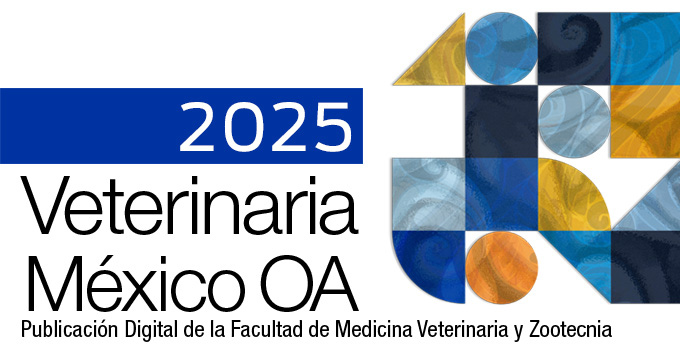Challenges for Mexican sheep production in the era of precision livestock farming and artificial intelligence
Main Article Content
Abstract
This narrative review discusses high-precision technologies applied to sheep production, with an emphasis on the use of computer vision and machine learning. It also reviews recent studies conducted in Mexico that have applied machine learning techniques to predict sheep body composition and image analysis methods to estimate body weight. These efforts have led to significant advances in the use of artificial intelligence models, such as You Only Look Once and Segment Anything, for monitoring and optimizing sheep production. In today’s interconnected world, decisions made in one context can immediately affect surrounding systems. Therefore, it is essential to consider individual animal welfare as a key factor in decision-making within production units, contributing to overall welfare. This article highlights emerging high-precision technologies in sheep farming, particularly those involving computer vision and machine learning.
Article Details
References
Vargas-Bello-Pérez E, López CA, Ruiz-Romero RA, Chay-Canul AJ, Lee-Rangel HA, Gonzalez-Ronquillo M, et al. A brief update on sheep production in Mexico: challenges and prospects. Tropical and Subtropical Agroecosystems. 2023;26(3). doi: 10.56369/tsaes.4872.
Secretaría de Agricultura y Desarrollo Rural. Detrás de la ovinocultura: una mirada a la crianza de ovejas en México. 2024. https://www.gob.mx/agricultura/es/articulos/detras-de-la-ovinocultura-una-mirada-a-la-crianza-de-ovejas-en-mexico
Marino R, Petrera F, Abeni F. Scientific productions on precision livestock farming: an overview of the evolution and current state of research based on a bibliometric analysis. Animals. 2023;13(14):2280. doi: 10.3390/ani13142280.
Morrone S, Dimauro C, Gambella F, Cappai MG. Industry 4.0 and precision livestock farming (PLF): an up to date overview across animal productions. Sensors. 2022;22(12):4319. doi: 10.3390/s22124319.
Tzounis A, Katsoulas N, Bartzanas T, Kittas C. Internet of Things in agriculture, recent advances and future challenges. Biosystems Engineering. 2017;164:31–48. doi: 10.1016/j.biosystemseng.2017.09.007.
Tedeschi LO, Greenwood PL, Halachmi I. Advancements in sensor technology and decision support intelligent tools to assist smart livestock farming. Journal of Animal Science. 2021;99(2):skab038. doi: 10.1093/jas/skab038.
Carabús A, Gispert M, Font-i-Furnols M. Imaging technologies to study the composition of live pigs: A review. Spanish Journal of Agricultural Research. 2016;14(3):e06R01. doi: 10.5424/sjar/2016143-8439.
Chay-Canul AJ, Tapia J, Canul-Solís J, Casanova-Lugo F, Piñeiro-Vázquez ÁT, Portillo-Salgado R, et al. Predictive biometrics of hair sheep through digital imaging. Veterinaria México OA. 2023;10. doi: 10.22201/fmvz.24486760e.2023.1150.
Olsen E V., Christensen LB, Nielsen DB. A review of computed tomography and manual dissection for calibration of devices for pig carcass classification - Evaluation of uncertainty. Meat Science. 2017;123:35–44. doi: 10.1016/j.meatsci.2016.08.013.
Kucha CT, Liu L, Ngadi MO. Non-destructive spectroscopic techniques and multivariate analysis for assessment of fat quality in pork and pork products: a review. Sensors. 2018;18(2):377. doi: 10.3390/s18020377.
Du C-J, Sun D-W. Recent developments in the applications of image processing techniques for food quality evaluation. Trends in Food Science & Technology. 2004;15(5):230–249. doi: 10.1016/j.tifs.2003.10.006.
Kongsro J. Estimation of pig weight using a Microsoft Kinect prototype imaging system. Computers and Electronics in Agriculture. 2014;109:32–35. doi: 10.1016/j.compag.2014.08.008.
Gomes RA, Monteiro GR, Assis GJF, Busato KC, Ladeira MM, Chizzotti ML. Technical note: Estimating body weight and body composition of beef cattle trough digital image analysis. Journal of Animal Science. 2016;94(12):5414–5422. doi: 10.2527/jas.2016-0797.
Morota G, Ventura RV, Silva FF, Koyama M, Fernando SC. Big data analytics and precision animal agriculture symposium: Machine learning and data mining advance predictive big data analysis in precision animal agriculture. Journal of Animal Science. 2018;96(4):1540–1550. doi: 10.1093/jas/sky014.
Vargas-Bello-Pérez E, Espinoza-Sandoval OR, Gonzalez M, Angeles JC, Chay-Canul AJ, Lee-Rangel HA, et al. The role of artificial intelligence in Latin American ruminant production systems. Animal Frontiers. 2024;14(6):23–32. doi: 10.1093/af/vfae034.
Camacho-Pérez E, Lugo-Quintal JM, Tirink C, Aguilar-Quiñonez JA, Gastelum-Delgado MA, Lee-Rangel HA, et al. Predicting carcass tissue composition in Blackbelly sheep using ultrasound measurements and machine learning methods. Tropical Animal Health and Production. 2023;55(5):300. doi: 10.1007/s11250-023-03759-1.
Muñoz-Osorio GA, Tırınk C, Tyasi TL, Ramirez-Bautista MA, Cruz-Tamayo AA, Dzib-Cauich DA, et al. Using fat thickness and longissimus thoracis traits real-time ultrasound measurements in Black Belly ewe lambs to predict carcass tissue composition through multiresponse multivariate adaptive regression splines algorithm. Meat Science. 2024;207:109369. doi: 10.1016/j.meatsci.2023.109369.
Chay-Canul AJ, Pineda JJ, Olivares-Pérez J, Ríos-Rincón FG, García-Herrera R, Piñeiro-Vázquez ÁT, et al. Prediction of carcass characteristics of discarded Pelibuey ewes by ultrasound measurements. Revista Mexicana de Ciencias Pecuarias. 2019;10(2):473–481. doi: 10.22319/rmcp.v10i2.4551.
Morales-Martinez MA, Arce-Recinos C, Mendoza-Taco MM, Luna-Palomera C, Ramirez-Bautista MA, Piñeiro-Vazquez ÁT, et al. Developing equations for predicting internal body fat in Pelibuey sheep using ultrasound measurements. Small Ruminant Research. 2020;183:106031. doi: 10.1016/j.smallrumres.2019.106031.
Shahinfar S, Al-Mamun HA, Park B, Kim S, Gondro C. Prediction of marbling score and carcass traits in Korean Hanwoo beef cattle using machine learning methods and synthetic minority oversampling technique. Meat Science. 2020;161:107997. doi: 10.1016/j.meatsci.2019.107997.
Aguilar-Quiñonez JA, Tırınk C, Gastelum-Delgado MA, Camacho-Pérez E, Tyasi TL, Herrera-Camacho J, et al. Prediction of carcass tissues composition using the neck and shoulder traits in hair lambs with multiresponse multivariate adaptive regression splines. Small Ruminant Research. 2023;227:107090. doi: 10.1016/j.smallrumres.2023.107090.
Fan N, Liu G, Zhang C, Zhang J, Yu J, Sun Y. Predictability of carcass traits in live Tan sheep by real‐time ultrasound technology with least‐squares support vector machines. Animal Science Journal. 2022;93(1):e13733. doi: 10.1111/asj.13733
Tedeschi LO, Greenwood PL, Halachmi I. Advancements in sensor technology and decision support intelligent tools to assist smart livestock farming. Journal of Animal Science. 2021;99(2):skab038. doi: 10.1093/jas/skab038.
Tedeschi LO. ASAS-NANP Symposium: Mathematical Modeling in Animal Nutrition: The progression of data analytics and artificial intelligence in support of sustainable development in animal science. Journal of Animal Science. 2022;100(6):skac111. doi: 10.1093/jas/skac111.
Torres-Chable OM, Tırınk, C, Parra-Cortés RI, Delgado MÁG, Martínez IV, Gomez-Vazquez A, et al. Classification of FAMACHA© scores with support vector machine algorithm from body condition score and hematological parameters in Pelibuey sheep. Animals. 2025;15(5):737. doi: 10.3390/ani15050737.
Hossein-Zadeh NG. Artificial intelligence in veterinary and animal science: applications, challenges, and future prospects. Computers and Electronics in Agriculture. 2025;235:110395. doi: 10.1016/j.compag.2025.110395.
Tırınk C. Comparison of bayesian regularized neural network, random forest regression, support vector regression and multivariate adaptive regression splines algorithms to predict body weight from biometrical measurements in Thalli sheep. Kafkas Üniversitesi Veteriner Fakültesi Dergisi. 2022;28(3):411-419. doi: 10.9775/kvfd.2022.27164.
Vázquez-Martínez I, Tırınk C, Salazar-Cuytun R, Mezo-Solis JA, Garcia RA, Orzuna-Orzuna JF, et al. Predicting body weight through biometric measurements in growing hair sheep using data mining and machine learning algorithms. Tropical Animal Health and Production. 2023;55(5):307. doi: 10.1007/s11250-023-03717-x.
Camacho-Pérez E, Chay-Canul AJ, Garcia-Guendulain JM, Rodríguez-Abreo O. Towards the estimation of body weight in sheep using metaheuristic algorithms from biometric parameters in microsystems. Micromachines. 2022;13(8):1325. doi: 10.3390/mi13081325.
Chay-Canul AJ, Camacho-Pérez E, Casanova-Lugo F, Rodríguez-Abreo O, Cruz-Fernández M, Rodríguez-Reséndiz J. Neural network-based body weight prediction in Pelibuey sheep through biometric measurements. Technologies. 2024;12(5):59. doi: 10.3390/technologies12050059.
Badgujar CM, Poulose A, Gan H. Agricultural object detection with You Only Look Once (YOLO) Algorithm: A bibliometric and systematic literature review. Computers and Electronics in Agriculture. 2024;223:109090. doi: 10.1016/j.compag.2024.109090.
Castro DP, Diniz FA, Lima FA, Silva TS, Silva APSE, Nolêto RMA, et al. Artificial intelligence applied to animal production. Ciência Rural. 2025;55(7):e20230520. doi: 10.1590/0103-8478cr20230520.
License

Veterinaria México OA by Facultad de Medicina Veterinaria y Zootecnia - Universidad Nacional Autónoma de México is licensed under a Creative Commons Attribution 4.0 International Licence.
Based on a work at http://www.revistas.unam.mx
- All articles in Veterinaria México OA re published under the Creative Commons Attribution 4.0 Unported (CC-BY 4.0). With this license, authors retain copyright but allow any user to share, copy, distribute, transmit, adapt and make commercial use of the work, without needing to provide additional permission as long as appropriate attribution is made to the original author or source.
- By using this license, all Veterinaria México OAarticles meet or exceed all funder and institutional requirements for being considered Open Access.
- Authors cannot use copyrighted material within their article unless that material has also been made available under a similarly liberal license.



